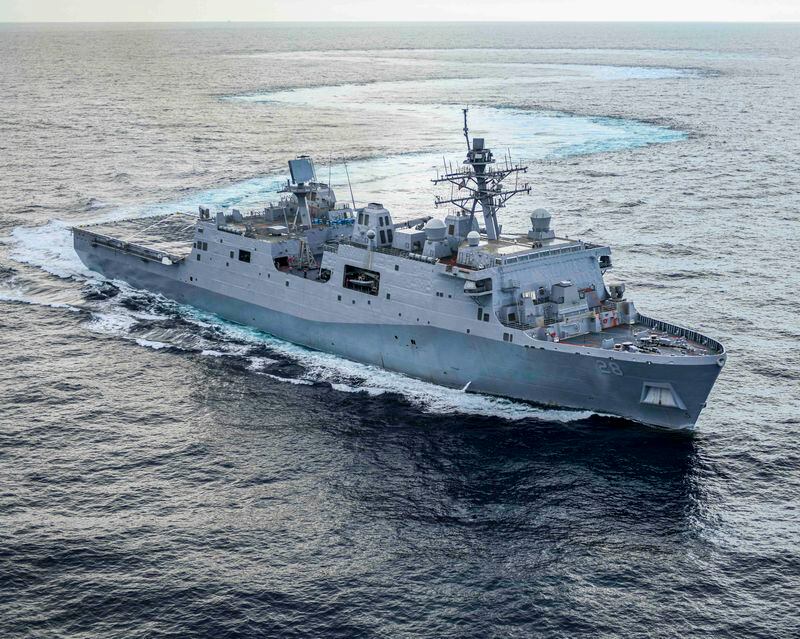ARLINGTON, Va. — The U.S. Navy is taking a “strategic pause” from buying amphibious ships, and using that time to study not just how many ships it wants but also the capabilities they should have when the service resumes buying them.
The Navy in its fiscal 2023 budget request last spring truncated the San Antonio-class amphibious ship production line. It asked to buy LPD-32 in FY23 and then would not buy any more LPDs for the foreseeable future, according to its budget documents.
Navy Secretary Carlos Del Toro has called this a strategic pause, noting at a defense industry conference last week that the service would “probably” resume buying these medium-sized amphibious ships after a pair of studies: a battle force ship assessment and requirement that considers the quantity of ships, and a capabilities-based assessment that focuses on the ship design and capabilities.
“I think, as we look forward to the future, there’s always going to be a need for amphibious capability in order to take Marines forward,” Del Toro said Feb. 22 at a National Defense Industrial Association conference.
But in making similar remarks earlier in the month at the West naval conference in San Diego, California, Del Toro referred to “a continuing need to build more LPD-like ships well into the future,” once the studies are done.
Asked about the “LPD-like” terminology, Brig. Gen. Marcus Annibale told Defense News that “there is a study being done right now to look at the medium-sized amphib ship cost-saving opportunities, and I would be getting ahead of anybody to say what the outcome would be.”
Annibale serves as the Marine Corps’ director of expeditionary warfare on the chief of naval operations’ staff.
The Navy in 2014 decided to take its San Antonio-class amphibious transport dock design, built at Ingalls Shipbuilding, and use it as the basis for a Flight II ship that replaces the aging Whidbey Island-class dock landing ships. These Flight II vessels are less capable than the original San Antonio ships — and cost about $400 million less apiece — but are significantly more capable than the Whidbey Island ships.
Annibale said this is the trade space the Navy and Marine Corps are eyeing to see if there are additional changes that could be made to lessen the cost of buying Flight II LPDs.
Speaking to Defense News following a panel presentation at the NDIA conference, Annibale noted the first Flight II ship is under construction, meaning the Ingalls production line has been unable to prove how much it can reduce cost ship-over-ship.
Still, he said, “we’re taking a look at other opportunities for cost savings.”
During Annibale’s panel, Capt. Judd Krier, the amphibious warfare branch head in the expeditionary warfare directorate, said: “We are doing a capabilities-based assessment in fiscal year ’23, really looking at the requirements for what the future amphibious force needs for presence, deterrence and crisis response.”
Krier added that the assessment was not designed “necessarily just to design a ship, although that is certainly possible and a potential outcome.” More broadly, though, the assessment would question what the sea service needs for “the future amphibious force to maintain its lethality and survivability and sustainability in support of all the range of operations.”

A key unknown amid the talk of reassessing LPD Flight II capabilities and design is how long the effort will take. The Navy will buy LPD-32 this current fiscal year. To keep the production line at peak efficiency, it would have to buy the next ship in FY25.
An industry source, who spoke on the condition of anonymity as the individual was not authorized to talk abut the Navy’s deliberations, said the shipbuilding industry has heard the battle force ship assessment and requirement study might end sooner, but that the capabilities-based assessment could last longer and threaten the service’s ability to resume buying LPDs or LPD-like ships in FY25.
Ingalls Shipbuilding leadership has consistently expressed a need to keep LPDs on two-year intervals, which allows the company to maintain a stable workforce and engaged suppliers.
Ingalls spokeswoman Kimberly Aguillard told Defense News that, with 12 San Antonios delivered and three under construction today, including the first Flight II ship, “this Navy-industry team is performing at maximum efficiency on two-year construction intervals. Continuing this cadence enables the most affordable approach to meet the nation’s minimum 31 amphibious warship requirement.”
Annibale, from his perch as the resource sponsor for the amphibious ships, also told Defense News that “we’re concerned because we want to keep LPD on two-year centers, and we think that’s important to keep doing that.”
The Navy is expected to release its FY24 budget request on March 9, with additional details coming out March 13. However, that budget request may not reveal much about the plans for the LPD program, as FY24 was meant to be an off year for buying the ships on a two-year cadence.
Megan Eckstein is the naval warfare reporter at Defense News. She has covered military news since 2009, with a focus on U.S. Navy and Marine Corps operations, acquisition programs and budgets. She has reported from four geographic fleets and is happiest when she’s filing stories from a ship. Megan is a University of Maryland alumna.








